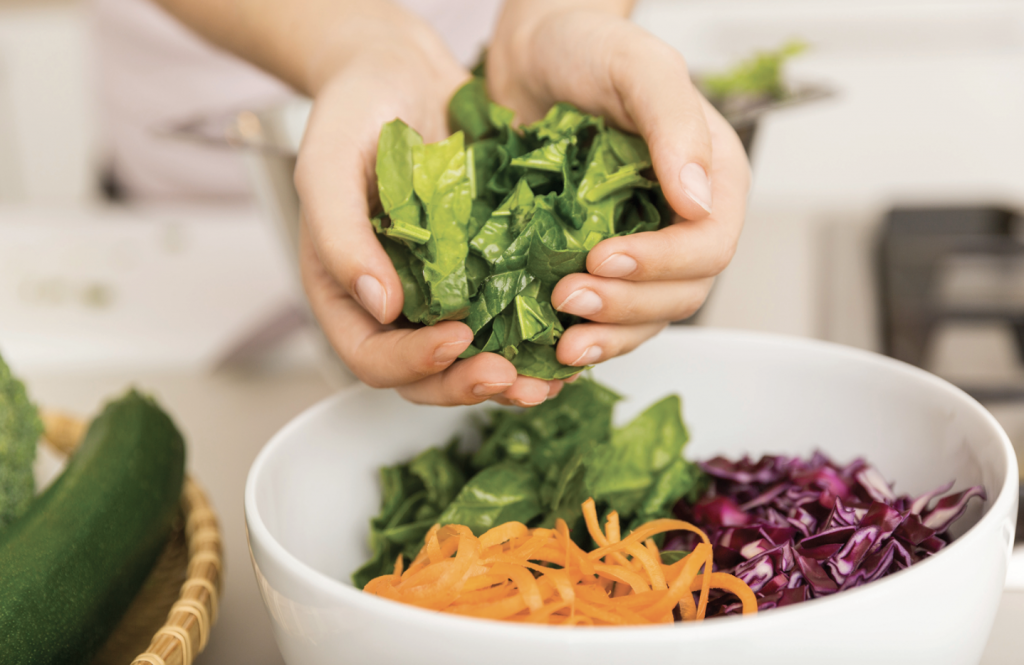
Fill ‘er up!
By Erin Wegner
We count, measure and obsess over calories, sodium and carbohydrates, but fiber is the one nutrient that most of us don’t get enough of. According to the Institute of Medicine, only 5% of people in the United States meet the daily target of 25 grams for women and 38 grams for men. But why aren’t we getting enough fiber in our diets?
It’s safe to say that many of us do not spend time in the kitchen planning and preparing our meals and snacks for the day. Instead of filling our plates and snack containers with fruits, vegetables, beans, nuts or seeds, many of us eat a high amount of processed foods. With your busy schedule, think about how many times you’ve used the convenience of a drive-through. Compared to a high-fiber lunch or dinner, how much fiber is in a double cheeseburger, fries and Mountain Dew?
A diet rich in fiber not only helps those of us who wish to shed a few pounds, but is also incredibly beneficial to our gastrointestinal health, lowering LDL (the bad cholesterol) and regulating blood sugar levels.
So, what is fiber and why is it so important? Fiber comes from plant-based products that we eat – fruits, vegetables, nuts, seeds, oatmeal and whole-grain products to name a few. It is essential for our digestion and our health. Fiber is a complex carbohydrate and our digestive system can’t directly digest it, meaning our intestines are not able to break it down into small enough units for our body to absorb. As a result, fiber helps us feel full sooner, adds bulk to stools and aids in regular bowel movements.
Fiber includes both soluble and insoluble fiber. Both are essential to our health and provide their own benefits.
Soluble fiber dissolves in water and forms a gel-like substance as it passes through the body. Soluble fiber is beneficial to the body because it makes you feel full. It also slows down digestion, which helps regulate blood sugar levels. Adding soluble fiber to your meals can help keep your blood sugar from spiking after a meal to crashing an hour or two later. Soluble fiber also aids in lowering LDL by absorbing the bad cholesterol and removing it through your stool, which can decrease your risk for heart disease.
Insoluble fiber doesn’t dissolve in water and travels through our body without much change. Insoluble fiber helps food travel through our digestive system and adds bulk to our stools, making it good for problems with constipation, diarrhea and hemorrhoids.
Both soluble and insoluble fiber benefit our bodies, so it’s good to get a mixture of both in your diet. Adequate fiber intake has been shown to reduce the risk of colon cancer and can be beneficial for a healthy weight. By feeling fuller longer, you’re less likely to overeat at meals or have unnecessary snacks throughout the day. This can lead to weight loss, which lowers your risk for certain diseases associated with obesity, including heart disease, stroke, high blood pressure, diabetes and cancer.
Add fiber to your diet gradually. Start by adding 5 grams (g) of fiber a day. Increase your water intake when you increase your fiber intake to prevent abdominal discomfort caused by gas, bloating and abdominal cramps.
If you need help adding fiber or other nutrients to your diet, Boone Hospital Center offers outpatient nutrition counseling with registered dietitians. To learn more or to schedule an appointment, please call 573.815.3870.